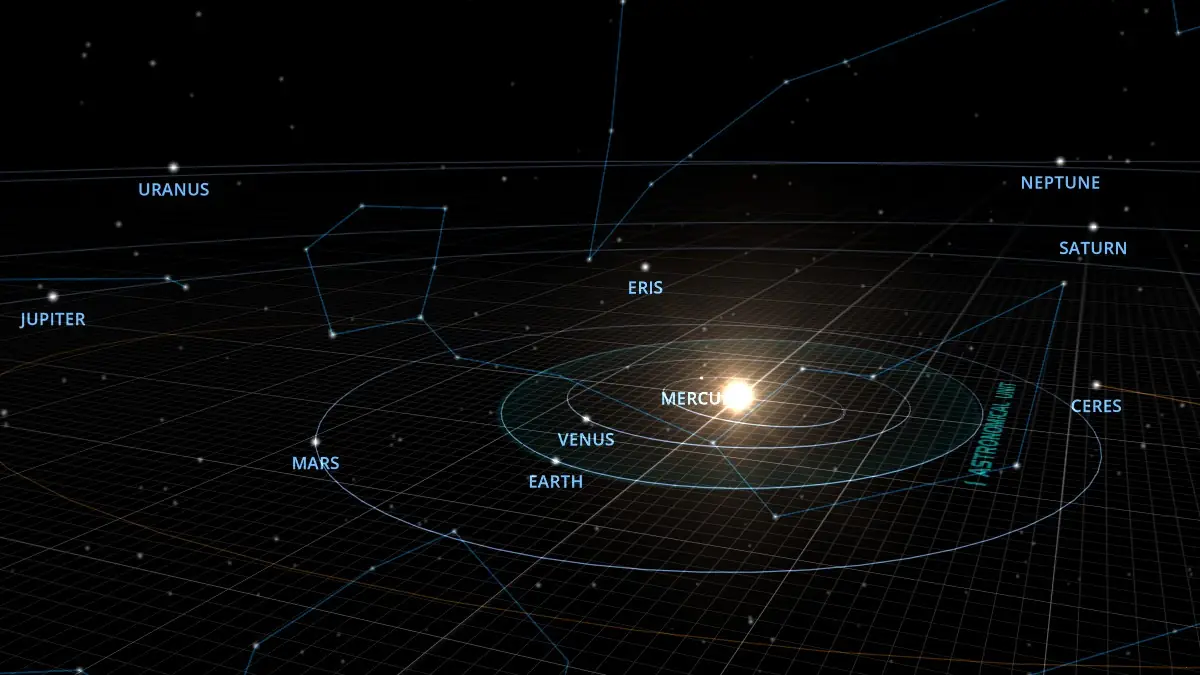Rare alignment of 7 planets to grace the sky on February 28, 2025
A rare celestial event will take place on Friday, February 28, 2025, when seven planets, Mercury, Venus, Mars, Jupiter, Saturn, Uranus, and Neptune will align in the evening sky.

Image credit: Solar System Scope, The Watchers
A rare celestial event will take place on Friday, February 28, 2025, when seven planets – Mercury, Venus, Mars, Jupiter, Saturn, Uranus, and Neptune will align in the evening sky.
The planetary alignment, commonly referred to as a “planetary parade,” presents a unique opportunity for skywatchers worldwide to observe multiple planets simultaneously.
The alignment will be visible shortly after sunset on February 28. Observers should look toward the western horizon to spot the planets appearing in a line. Mercury, Venus, Mars, and Jupiter will be easily visible to the naked eye, while Uranus and Neptune will require binoculars or a telescope because of their lower brightness. Saturn will be the most difficult to observe as it will be positioned close to the Sun and may be obscured by its glare in some locations.
Observers should find a location with minimal light pollution and an unobstructed view of the horizon for optimal viewing. The best time to begin observations is just after sunset when the planets are above the horizon but before they set, according to astronomers.
Mars, with a magnitude of -0.4, will be the highest in the sky, positioned in the constellation Gemini. Jupiter, shining at -2.3 magnitude, will be slightly lower in the constellation Taurus and will be the second brightest planet visible. Uranus, with a magnitude of 5.8, will be located near the border of Taurus and Aries.
Using binoculars is recommended for a clearer view, although theoretically visible to the naked eye. The brightest of all, Venus, will have a magnitude of -4.8 and will be found in the constellation Pisces.
Neptune, with a faint magnitude of 7.8, will be positioned close to the western horizon in Pisces, requiring a powerful telescope for observation. Mercury, shining at -1.2 magnitude, will be low in the sky in the constellation Aquarius and will be visible for only a short time after sunset. Saturn, with a magnitude of 1.1, will be extremely close to the Sun, making it the most challenging planet to observe. Observers will need precise timing and an optimal location to spot it before it sets.
This planetary alignment coincides with the New Moon, providing an excellent opportunity to observe fainter celestial bodies without interference from moonlight.
Catching all seven planets at once requires precise timing, as Saturn will set early, reducing the observation window. To improve the chances of spotting each planet, using a stargazing app like Star Walk 2 to track planetary positions in real-time is recommended. Choosing a dark-sky location with no obstructions along the western horizon will ensure the best visibility. Observers should start their observations as soon as the Sun sets to maximize the opportunity before the planets dip below the horizon.
A telescope with a 20 cm (8 inches) aperture is ideal for spotting Uranus and Neptune, while a magnification of at least 25x is recommended for viewing Saturn’s rings and Jupiter’s moons.
Planetary alignments occur when multiple planets appear close together in Earth’s sky because of their positions in their respective orbits. This happens when the planets gather on the same side of the Sun, aligning from Earth’s perspective. While perfect linear alignment is nearly impossible because of the varying orbital planes, events like this create an impressive visual spectacle.
The last time all seven planets were visible together in the night sky was in April 2024. The next similar alignment is not expected until September 2040, making this a rare and noteworthy event for astronomers and enthusiasts alike.
Several other notable planetary alignments will occur beyond February 28. On April 17, 2025, Neptune, Mercury, Saturn, and Venus will align in the morning sky. On August 10, 2025, a large alignment will take place before sunrise, featuring Mercury, Jupiter, Venus, Uranus, Neptune, and Saturn.
On February 28, 2026, another major alignment will occur involving Mercury, Venus, Neptune, Saturn, Uranus, and Jupiter. On August 10, 2026, an alignment of Jupiter, Mercury, Mars, Uranus, Saturn, and Neptune will be visible in the morning sky.
References:
1 Planetary Alignments and Planet Parades – NASA – February 4, 2025
2 Planets Align on February 28, 2025: How to See the “Great Planet Parade” – Star Walk 2 – February 23, 2025
Rishika holds a Master’s in International Studies from Stella Maris College, Chennai, India, where she earned a gold medal, and an MCA from the University of Mysore, Karnataka, India. Previously, she served as a Research Assistant at the National Institute of Advanced Studies, Indian Institute of Science, Bengaluru, India. During her tenure, she contributed as a Junior Writer for Europe Monitor on the Global Politics website and as an Assistant Editor for The World This Week. Her work has also been published in The Hindu newspaper, showing her expertise in global affairs. Rishika is also a recipient of the Women Empowerment Award at the district level in Haryana, India, in 2022.



“Thus says The Lord: Behold all creation! Is it not beyond the comprehension of men? Can any man number the galaxies in the heavens or count the stars thereof? And what of the love of The Father, fulfilled through The Son? Is it not also beyond comprehension?
Come together and reason, O sons of men. Look upon the works of My hands, and see with new eyes and restored vision, that you may behold the Truth. For all the works of man are here for but a moment, then quickly pass away. And that which remains, shall it not become fuel for the fire in the Day of The Lord’s Anger? And the knowledge of man, is it not foolishness in My eyes, coming to nothing before the light of My Glory?
Therefore fear The Lord your God, and accept the truth of who I am. For the fear of The Lord is the beginning of wisdom, and the knowledge of The Holy One is understanding. For I am God alone.”
(From The Volumes of Truth, Volume One, an excerpt from “God Eternal”)